Old and New
The spring issue was an amazing mix of the old and the new—descriptions of some incredible people keeping the values we cherished in more bygone days when I attended Pomona and later practiced pediatrics in Claremont, and the far-out stereoscopic pictures of beautiful California.
It was uplifting for me to hear of Dr. Juan Guerra’s perseverance as he pursued his desire to truly serve his community. I was also pleased to learn that when he was told he wasn’t going make it because of his failure of a biology course, he seemed to realize that the art of medicine was more important than the science. I find that too much emphasis on the science of medicine can lock a physician into a system that won’t allow innovation and cuts off knowledge the physician can gain by listening to his/her patients.
Matt O’Connor, the young man of many talents, unabashedly speaks of his part in Christian Athletes, which shows he is aware of where his talents come from.
The addition of the stereoscopic pictures of naturally beautiful California provided some real nostalgia and balanced the “old” with the “new.”
Let me know if anyone remembers a kindly pediatrician who practiced in Claremont in the ‘60s. He has two pediatric books, with an emphasis on nutrition, that can be browsed on Amazon: books, Ralph Campbell.
—Ralph K. Campbell, M.D. ’50
Polston, Montana
3D Collector’s Item
I appreciate the quality of the content and the professional design of the Pomona College Magazine compared to similar endeavors from other colleges and universities. Your magazine outshines any others I have seen; and I hate to admit, I have attended classes or completed degrees at Scripps College, University of Colorado, University of South Florida, Western Michigan University, The University of Kansas, and Gonzaga University in addition to Pomona College (class of 1970). I am writing because you really outdid yourselves with the Spring 2014 issue. I absolutely loved the 3D photos and appreciated greatly the way you interweaved them from front cover to content to back cover. I have been in love with 3D since the early 1950s Viewmasters and 1953 Hollywood 3D films. You did an outstanding job; what a find to have come across 1870s stereo views of California (I am what was known in the past as a “prune picker,” an old term for someone who was born, raised and lived in California. My dad, Leland Williams [class of 1929], also had this distinction.)
Thanks so much. I will be adding this very special issue to my extensive collection of 3D photography.
—Randy Lee Williams ’70
Spokane Valley, Washington
Environmental Faux Pas
During my son’s remarkable time at Pomona, his mother and I have immensely enjoyed the Pomona College Magazine. And this compliment comes from a magazine publisher (we own three in the field of recycling).
But the Spring 2014 issue was designed with a serious environmental error. The inclusion of 3D lenses was a major mistake on your part. Only two things can happen with these non-recyclable items. The reader might not put them on, and thus the lenses end up contaminating the paper recycling stream, or they end up in the trash. The other result is the reader uses them, and then throws them away.
So it seems your decision meant you harmed paper recycling or added to the waste stream. I think a so-called technology vendor sold you a bill of anti-environmental goods.
Again, I compliment you on a wonderful product. Your product is remarkably comprehensive and well-written. But in the future, please assess the environmental consequences when you consider any publishing changes (paper, inks, etc.). As one publisher to another, I’d love to provide advice to make sure poor environmental decisions such as this do not occur again.
Go Sagehens!
—Jerry Powell
Portland, Oregon
Time for Divestment
The time has come for Pomona College to divest its endowment from the fossil fuel industry and redirect its investments into the energy sources of the future. I don’t believe I need to go into detail about why fossil fuels are problematic, as 97% of the world’s scientists have long since identified human use of fossil fuels as the primary driver of climate change.
I am certainly not the first to suggest the College make such a move. For 18 months Pomona students have been asking for change, yet last September President Oxtoby and the Board of Trustees rejected divestment, claiming it would cost the school $485 million in lost earnings and citing the many environmental initiatives occurring on campus.
I am proud of the work Pomona College has done to receive a gold rating from the Sustainability Tracking, Assessment, and Rating System (STARS), its LEED-certified green buildings, and its environmental analysis academic program. But that is not enough.
I live in Montana, a place with a lot of beautiful, unspoiled landscapes and rivers. But it also has coal strip mines, and its pristine nature is increasingly under threat from fracking as a means of oil and gas development. In addition to harmful climate-change emissions such as fugitive methane from oil and gas extraction, fossil fuel development has extensive impacts on the land, surface water, groundwater and air sheds. Aquifers are polluted, residents get nosebleeds from the fugitive methane, and spills occur regularly, killing fish and waterfowl.
People protest, and the fossil-fuel industry uses heavy-handed tactics to buy off politicians and silence dissent. This is happening here in my home, Montana.
I do what I can as an architect, homeowner and bicycle commuter to implement a fossil-fuel-free future, but I know that my action alone is not enough. And far too much is at stake. So I work long hours through a local citizens’ group to hold industry and governing powers accountable. I would like to have my alma mater, Pomona College, as an ally in this work rather than as an opponent. And I am only asking Pomona to uphold its stated core values, as I have challenged myself to do.
I call upon President Oxtoby and the Board of Trustees to become committed and creative about working toward a divestment solution as though their lives depended on it. In the big picture, my life, my home and everyone’s lives do.
—Ed Gulick, ’94
Billings, Montana
Error Card
According to Wikipedia, an “error card” is “a trading card that shows incorrect information or some other unintended flaw.”
Alas, your Summer 2013 issue’s “Pomona All-Stars” baseball card of Mike Salk ‘00, which shows him standing in front of a large banner proclaiming Boston sports radio station WEEI 103.3 FM, has been rendered an “error card” just a half-year after the magazine’s publication.
Although it was the perfect job for Salk, a known—and deeply knowledgeable—sports fanatic since his undergraduate days, it was also an impossible situation: ever since the advent of a rival sports radio station, 98.5 The Sports Hub, WEEI has been inexorably bleeding listeners, ratings and advertisers in the metro Boston market.
An upper-management shakeup, new hires (such as Salk) and other innovations have so far proven unable to resurrect WEEI’s “brand,” as 98.5 is now perceived as the younger, hipper alternative to the “dinosaur” that is WEEI. Not even a cross between the two Howards—Cosell and Stern—could revive WEEI’s fortunes.
With his dedication, intelligence, and likeability, it is no surprise that Salk has already landed on his feet with a new announcing job at Seattle’s ESPN 710.
Perhaps PCM can quietly airbrush out, Soviet-style, the “WEEI 103.3” from the online version of Salk’s “Pomona All-Stars” card, and replace it with “ESPN 710”?
Teasing with affection…
—Doug Meyer ‘01
Waltham, Massachusetts
Drumbeats
James Schlesinger, the rare public servant who served in the Cabinet of both Republican and Democrat presidents, died last week. He was Secretary of Defense for Presidents Nixon and Ford, and later Secretary of Energy for President Carter. He also headed the CIA when its credibility was threatened at the height of President Nixon’s Watergate scandal. Schlesinger was brilliant and blunt, two qualities that don’t always show up together and don’t always work well together in Washington. I met Jim in the 1990’s when we were seated together at a luncheon. As people do in Washington, we looked for common ground. When I told him I was a graduate of Pomona, he immediately started singing, “Drumbeats, drumbeats, drumbeats rolled over the silence profound, high above Pomona, he ne terra toma.” A Harvard man, Jim was in a college singing group when he heard the Pomona men sing “Torchbearers” nearly 50 years earlier. He called it the best college song he had ever heard, bar none. Neither of us knew that “Torchbearers” would become the painful subject of campus debate a few years later. Some were offended by the made-up dialect and the historically inaccurate imagery of Native Americans in the Pomona Valley. Those who loved the song and paid little or no attention to the words thought the controversy was political correctness gone berserk. After a lengthy study, a special committee recommended (if my memory serves) that in the future the song should only be sung at alumni gatherings and only if the offensive words were changed. Sounds like a Washington, D.C., solution (unless it deals with the Redskins). I wonder what ever became of “Torchbearers.” Like Jim Schlesinger, I’ve never been able to get those wonderful, haunting sounds out of my head. If today’s students don’t get to hear it, it’s a shame.
—Allen Moore ‘66
McLean, Virginia
Saddened
I was deeply saddened to learn that my classmate, Emory Zimmermann had passed away. I sang first soprano in the Women’s Glee Club, and Emory sang bass in the Mens’ Glee Club. I earned Emory’s annoyance one year by lining up not one but two speakers for the Annual Glee Club Banquet: my great uncle, Howard Ross (‘04), an early member of the Men’s Glee Club, and my grandmother, Katharine Bird Twinting (‘04) who knew the origins of “Torchbearers.” She knew Prof. Brackett and David Barrows who copied the music from the local Indians and turned it into Pomona’s “Torchbearers.”
“Torchbearers” requires low basses. Fortunately, Emory had a deep bass voice. One could always hear Emory singing the bass part. Though we grieve that his voice is now stilled, in my mind’s eye, I can always recall the resounding sound of “Torchbearers” and Emory singing the low bass part.
He will be missed by us all.
I was also saddened to learn that my academic advisor, Edwin A. Phillips, emeritus professor of botany, had passed away. I rarely agreed with him, but I was part of the NSF grant studying hybridization of Quercus dumosa x Quercus douglasii. I did complete my Ph.D. magna cum laude in 1966 at the University of Bern, Switzerland, with a dissertation on photosynthesis.
I left biology for physics in 1970, but the Botany Gang was a unique group.
—Katharine Holtom Jones ‘61
Alpine, California
[Alumni and friends are invited to email letters to pcm@pomona.edu or “snail-mail” them to Pomona College Magazine, 550 North College Ave., Claremont, CA 91711. Letters are selected for publication based on relevance and interest to our readers and may be edited for length, style and clarity.]
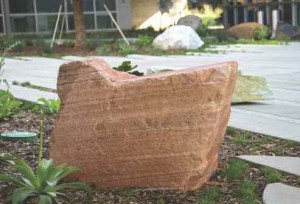
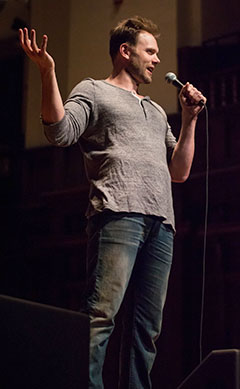 Comedian Joel McHale entertained a packed house of Claremont Colleges students at Little Bridges on Saturday night.
Comedian Joel McHale entertained a packed house of Claremont Colleges students at Little Bridges on Saturday night.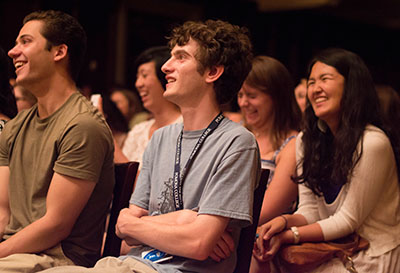
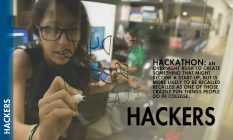
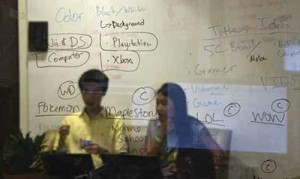 Welcome to the 5C Hackathon, the all-nighter that lures as many as 250 students from The Claremont Colleges each semester to stay up building creative and often elaborate software projects and apps in a mere 12-hour span. It is a deadline-driven, energy-drink-fueled rush to create something that just might become a Silicon Valley startup but is more likely to be remembered as one of those crazily fun things people do in college when they are alight with intelligence and passion.
Welcome to the 5C Hackathon, the all-nighter that lures as many as 250 students from The Claremont Colleges each semester to stay up building creative and often elaborate software projects and apps in a mere 12-hour span. It is a deadline-driven, energy-drink-fueled rush to create something that just might become a Silicon Valley startup but is more likely to be remembered as one of those crazily fun things people do in college when they are alight with intelligence and passion.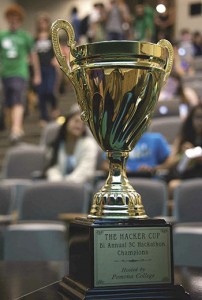 While some hackathons have gone grander and glitzier—MHack at the University of Michigan awarded a $5,000 first prize this year and HackMIT drew 1,000 competitors to compete for $14,000 in prizes at the Massachusetts Institute of Technology last year—the 5C Hackathon has remained doggedly itself. “We really wanted, instead of pushing for bigger things, to think about how we can get more people into this,” Pollak said. “You’ll see people present (projects) in the morning who didn’t know how to code at the beginning of the week and who actually built something. It’ll be small and ugly, but it will work.”
While some hackathons have gone grander and glitzier—MHack at the University of Michigan awarded a $5,000 first prize this year and HackMIT drew 1,000 competitors to compete for $14,000 in prizes at the Massachusetts Institute of Technology last year—the 5C Hackathon has remained doggedly itself. “We really wanted, instead of pushing for bigger things, to think about how we can get more people into this,” Pollak said. “You’ll see people present (projects) in the morning who didn’t know how to code at the beginning of the week and who actually built something. It’ll be small and ugly, but it will work.”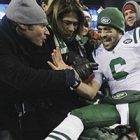
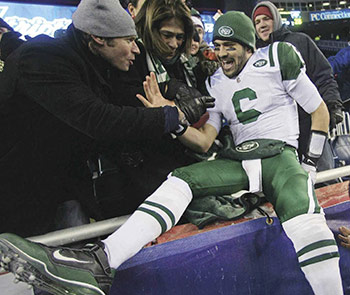 After graduating from Pomona with a degree in English, and playing for four years on the Sagehens football team, Kessler jumped right into his current field working at IMG Sports with Tom Condon, ranked by Sports Illustrated as the most influential sports agent in the country last year. Kessler, whose father has been a long-time legal representative for the NFL Players Association, had already served an internship with NBA agent Marc Fleisher while attending Pomona, traveling with 18-year old client Tony Parker to various NBA workouts (Parker has since gone on to win four NBA titles with the San Antonio Spurs and former Sagehen coach Gregg Popovich).
After graduating from Pomona with a degree in English, and playing for four years on the Sagehens football team, Kessler jumped right into his current field working at IMG Sports with Tom Condon, ranked by Sports Illustrated as the most influential sports agent in the country last year. Kessler, whose father has been a long-time legal representative for the NFL Players Association, had already served an internship with NBA agent Marc Fleisher while attending Pomona, traveling with 18-year old client Tony Parker to various NBA workouts (Parker has since gone on to win four NBA titles with the San Antonio Spurs and former Sagehen coach Gregg Popovich).